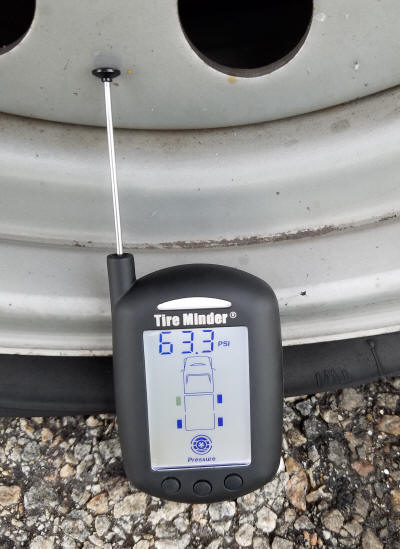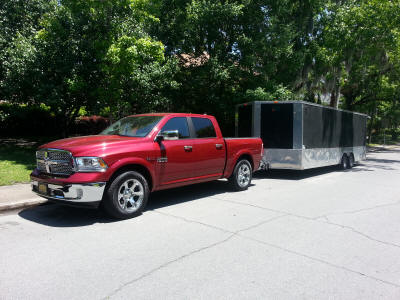Towing and Trailers
| Driving your race car to events. It's
common for folks considering the jump to racing to consider the idea of
driving their race car to events. Lost this idea. Even for those that do
actually try it, the scheme never works for long. The ride of the harsh
race springs during the drive to the track would be torture, and the
lack of cargo room would make everything difficult. Suck it up and find
an inexpensive tow vehicle and trailer. When I transitioned from tracking my daily driver to racing, I sold the daily driver for $30k and bought: '97 BMW 328, $2500. Looked good and was really a nice little car. '99 Dodge Ram pickup, $1500. Used trailer, $1500 This kind of light weight rig is easy to tow. Don't need a weight distribution hitch.
|
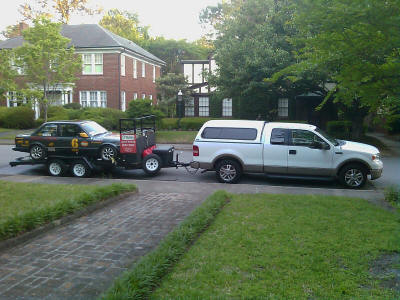
|
| Towing manners.
Tongue weight. The rule of thumb is 10-15% of the trailer's weight on the hitch ball. Too little tongue weight and your trailer will want to sway, which can be alarming. The solution is a little trial and error. Load up your trailer and mark the position of your race car. Try to put the car's center mass right between the trailer's axles. As you go to events, month after month, sneak your car backwards bit by bit. Your objective is to find some happy place such that the race car is pretty far rearward on your trailer, yet the trailer's handling is reliably docile. https://www.youtube.com/watch?v=nd-hUX8memY What to do if your trailer starts swaying. Staying on the throttle, use your trailer brake controller to apply a little braking to the trailer. What you don't want to do is back off the throttle because that will usually exacerbate the swaying. Since backing off the throttle is the natural reaction, you need to wargame "don't lift" a bit to help ensure you do the "right thing" not the "intuitive thing" when your day comes. Practice reaching for the brake controller while staying on the gas so this action isn't a "new thing". If, each time you pick up your trailer, as you drive away you use your brake controller to confirm that your trailer brakes are working, you'll nicely reinforce the same actions you'll need should your trailer suddenly get a bad sway.
|
|
| One thing you can do to improve your
trailer's manners is to move your truck's hitchball forward. This works
because the distance from hitch ball to your truck's rear axle is the
lever arm the trailer uses to move your truck around. The shorter you
make the distance between hitch ball and truck rear axles, the harder it
is for the trailer to move your truck. This is true both in terms of
lateral force (sway) but also vertical force, which the weight on your
front tires.
You can move your truck's hitch ball forward by drilling another hole in the hitch "shank" for the hitch "pin". It's a pretty big hole and the shank is a thick piece of solid steel, but you'll like the result. Just plan it out carefully so you create trouble for the truck's tailgate going down when the trailer is hitched up. Be a bummer for the tailgate to mar itself on the trailer tongue every time you drop it down. Related to this, you will find that some SUVs have a relatively short distance between rear axle and hitch ball. This short lever arm gives the SUV nice towing manners.
|
|
| Weight distribution hitches. There's some
disagreement about weight distribution hitches. I'll give you my take,
and I'll point out where there's less consensus.
The purpose of a weight distribution (WD) hitch is to shift some weight from the truck's rear wheels to the front wheels. Primarily reducing "porpoising" where, after driving over an elevation change, the truck wants to go nose up, nose down, nose up until the shocks stop the motion. The heavier your trailer and the lighter your tow vehicle, the more
you need a WD hitch. Also, the shorter the wheelbase on your tow
vehicle, the more it would it would benefit from a WD hitch. Anti-sway. There are lots of designs of WD bars. Most of them also have anti-sway functionality. This is because if there is lateral movement of either trailer or truck, the draw bars will tighten, pushing back against this movement. So when you are choosing a WD design, look at it carefully an consider if the draw bars will tighten when you turn. If your WD hitch has no anti-sway functionality, consider getting an additional anti-sway assembly on your WD hitch. These are usually friction based and simply resist lateral movement of truck and trailer. Seems a lot easier to me tho to just get a WD hitch design that has inherent anti-sway functionality.
|
|
| Trailer tires. Suck. I've yet to fine
compelling evidence that a make/model of trailer tire exists that can be
depended on.
What ever trailer tire rating (C, D, E, etc) "ought" to be enough for your trailer, go up 2 grades. Do this immediately. This will be the single greatest thing you can do to reduce the # of trailer tire flats. The first time you have to change your trailer tire on the side of the road, at night, in the rain, with speeding cars missing your crouching figure by inches, you'll decide cost is no object in pursuit of reliable tires. If you buy a used trailer and the tires are >3yrs old, buy new ones. That means a new spare too. I once had an "age unknown" spare last only a single hour before it too, came apart. Watch your tire wear patterns for anything strange. It's common to have toe or camber problems on trailer wheels. Do a practice effort of changing a tire. This will ensure that you have the tools necessary and you'll be a well oiled machine when your first flat comes. Get a Tire Pressure Measuring System. It took me 3 tries to find one
I could rely on, and that would give me info as soon as the wheels
started turning. Google TST TPMS. The reason this is a big deal is that
it will help ensure that you never start a trip with your tires a bit
low.....the big killer of tires. Also, the TPMS system will immediately
alert you as to the flat. People assume that they'll always be able to
feel that their trailer has blown a tire. But the reality is that
sometimes you'll detect the tire blowing, and sometimes you won't. Have 2 spare tires, especially if you have an enclosed trailer. On 2 trips in 10yrs, I've had to use both spares. Never put your jack under a trailer axle unless it's the very end of the axle at the spring. Trailer axles are weak noodles. |
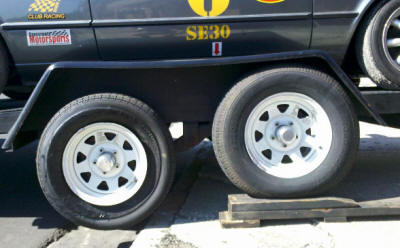 Unprepared for flat. Had to use a ramp and curb to get tire up.
Crappy TPMS unit showing 63psi for flat tire. |
| Misc trailer thoughts. Mpg and speed. Open trailers don't have much aero drag unless you've got tires in an overhead tire rack. Consider putting tires in your overhead tire rack only if you really need to put them there. Otherwise, find some other place to stash them. Enclosed trailers create lots of aero drag. Keep in mind that force due to aero drag is proportional to the cube of speed. So a small increase in speed makes a big difference. Moving up from an open trailer to an enclosed trailer. I spent 5yrs in an open trailer. In retrospect, I should have moved to an enclosed trailer earlier. The increase in standard of living that comes with an enclosed trailer is huge. You, all your tools, and the rest of your gear, in an enclosed trailer sleep dry, warm, and comfortable. Sleeping under a tarp thrown over the open trailer's tire rack got old on those weekends that were cold and wet. I will always be grateful to the various folks, especially Julio Palacio, for all the times they let me sleep in their RV. Size of enclosed trailer. Don't go smaller than 24'. A 20' trailer has the same amount of aero drag and isn't much lighter. But the extra 4' of room will mean the difference between having 4' of space in front of your car, and 4" of space in front of your car. The different in "usability" is huge. Tow capacity of your truck. Don't get too wrapped up in this. I used to be a big believer in the school of thought that one should be very conservative re. having "plenty of truck". Be we all get smarter as we get older. Tow capacity ratings are arrived at via a battery of tests. Those tests don't necessarily reflect your values. For example, two of the tests are directly associated with engine peak power. One test is a short launch of a steep hill, and the other is a long pull up a steep hill. The latter test also puts significant stress on the cooling system. When people get excited about tow capacity ratings, they talk about
having enough brakes and the truck being a "stable towing platform" a
product of truck weight, wheelbase, track width, and suspension design.
But what seems to actually set towing capacity isn't any of that. It's
the engine and the cooling system. This is one of those examples of
having to look behind the scenes and see what is really going on when
"common wisdom" is attempting to answer something for you. So if your trailer scheme sounds like it might be a little too heavy for your truck, don't obsess over it. You may find that even if your trailer a little heavy, your truck does a fabulous job towing. If, however, your trailer is likely to be a couple thousand pounds too heavy, then yes, maybe it's time for a bigger truck. Background. A higher ratio diff means more engine rpms at a given mph. Remember those drag race tests to establish tow rating. People often talk as if a higher ratio diff means that their engine will turn more rpms at all speeds. But the reality is that that your tranny will shift whenever it hits the programmed shift points of rpm and load. So your transmission is in total control of engine rpm, as long as it doesn't run out of gears of the engine out of rpms. How often do you run out of gears or rpms? Probably about never. The tow rating tests runs out of gears or rpms 2x, and that's why the diff changes the tow ratings. When the truck is "launched" in the tow tests the tranny will downshift to 1st gear, since it has no lower gear, the diff matters. The higher ratio diff will allow the tranny to run to it's 2nd gear shift point faster. In the long pull up the mountain test, a couple seconds after the launch the engine will reach a steady state WOT doing as much pulling as it's HP will allow. What ever gear it settles in, the engine will have more hp in that gear at the higher rpm that the higher ratio diff allows.
Gas vs. diesel. Diesel engines are inevitably a bit better on fuel, but this is especially true when towing. So whereas my EcoD might be rated at only 15% better mpg than an F-150 EcoBoost on the freeway, I can expect probably 80% better mpg towing. Gas engines really suck fuel, especially turbo engines, when push them harder then the couple dozen hp needed to maintain freeway speeds, especially turbo engines. Hp vs. torque. Don't get too wrapped up in torque #'s. Car magazines have screwed up 60yrs of car enthusiasts re. what engine torque actually means. Torque can be thought of as "hp at low rpm", which is interesting, but since you can get more hp by just increasing rpm, "hp at low rpm" is a lot more interesting to the marketing department then it ought to be to you. My diesel engine has 240hp. If your gas engine has 480hp, than
you honestly have 2x as much power as me. And "power" is just what it
sounds like...."power". It's the real deal. The "pulling power Buying a used trailer. If you're low on funds, find the best used trailer you can. New cheap trailers are usually crap and the money you saved up front will be spent repairing your turd. How to distinguish, when reading only marketing materials, between a
probably enclosed good trailer and a probably crappy enclosed trailer.
Good trailers are structurally more stout. Read carefully the spacing
and design of the reinforcing members under the floor, walls, and
ceiling. For example, 16" spacing between ceiling members means a
terrific trailer. Expect it to be heavier. 24" spacing between wall
members means a POS trailer. Near as I can tell, all aluminum trailers are fabulous.
|
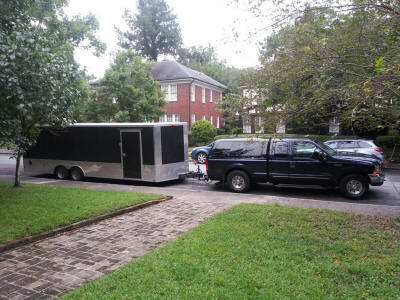 F-250 Powerstroke diesel and 24' V nose trailer
Ram 1500 Ecodiesel. Same mpg towing as long as I don't go hard up mountains. Vastly more comfortable, quietly and "sure" tow vehicle despite having significantly less tow capacity than the F-250. The EcoD got spec'd with a radiator a mite small tho. |
